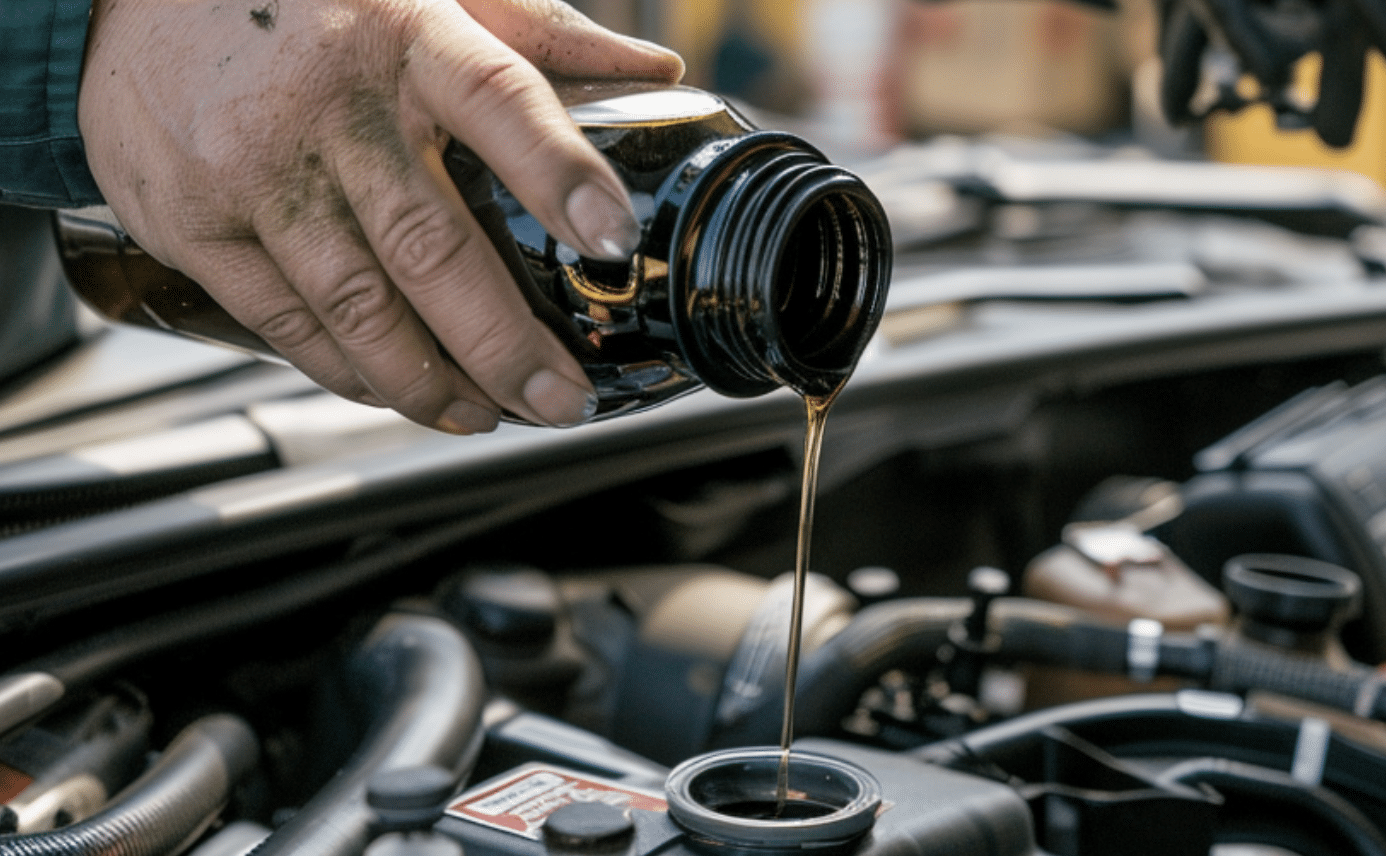As a car owner, you know that regular maintenance is key to keeping your vehicle running smoothly and avoiding costly repairs. One of the most important aspects of car maintenance is changing your engine oil at the right intervals.
In this definitive guide, we’ll cover everything you need to know about oil changes, from understanding the different types of oil to determining the optimal change interval for your car.
By following our expert advice, you can keep your engine healthy and extend the life of your vehicle. We’ll cover engine oil’s purpose, the factors influencing oil change frequency, and how to choose the right oil for your car.
Let’s dive in and learn how to maintain your car’s oil change schedule like a pro.
Understanding Engine Oil
Engine oil plays a vital role in the performance and longevity of your vehicle’s engine.
Engine oil provides lubrication, cooling, and cleaning, helping to reduce friction and wear, regulate engine temperature, and prevent the buildup of harmful contaminants.
There are three types of engine oil:
| Type of Engine Oil | Best Use Case | Cost-Effectiveness | Performance in Extreme Conditions | Maintenance Schedules |
|---|---|---|---|---|
| Conventional Oil | Regular driving conditions | Most cost-effective | Less effective | Requires more frequent changes, typically every 3,000-5,000 miles |
| Synthetic Oil | High-performance and extreme conditions | More expensive | Superior performance | Longer intervals between changes can be up to 10,000-15,000 miles |
| Synthetic Blend Oil | Balance for moderate driving conditions | Moderately priced | It is better than conventional, but not as good as full synthetic | Medium intervals often suggested between 5,000-7,500 miles |
The Importance of Regular Oil Changes

Critical Role of Oil Changes in Engine Health and Longevity Regular oil changes play a vital role in maintaining the health and longevity of your vehicle’s engine.
Just as the human body needs blood to function properly, an engine relies on clean oil to run smoothly.
By routinely changing your car’s oil, you ensure your engine receives the necessary lubrication and protection, extending its lifespan and saving you from costly repairs.
1. Improved Fuel Efficiency
One key benefit of regular oil changes is improved fuel efficiency. As oil circulates through the engine, it picks up dirt and debris, becoming thicker and less effective at reducing friction.
This increased friction forces the engine to work harder, consuming more fuel.
By replacing old, contaminated oil with fresh, clean oil, you minimize friction and allow your engine to run more efficiently, ultimately saving you money at the gas pump.
2. Reduced Engine
Wear Another crucial advantage of timely oil changes is reduced engine wear.
The moving parts inside your engine, such as pistons and valves, rely on a thin layer of oil to prevent metal-on-metal contact.
Over time, oil breaks down and loses its ability to lubricate effectively, leading to increased wear and tear on these components.
Regular oil changes ensure that your engine’s parts remain well-lubricated, minimizing wear and extending its life.
3. Maintaining Warranty
Coverage Many car owners may not realize that neglecting to change their oil at the recommended intervals can void their vehicle’s warranty.
Manufacturers often require proof of regular maintenance, including oil changes, to keep the warranty valid.
By adhering to the prescribed oil change schedule, you protect yourself from potentially high repair costs that would otherwise be covered under warranty.
Determining Your Oil Change Schedule
Traditionally, the recommended oil change interval was every 3,000 to 5,000 miles. However, this guideline has evolved over time due to engine design and oil quality advancements.
Today, the ideal oil change interval varies depending on the vehicle’s make and model and the type of oil used.
While some vehicles may still require oil changes every 3,000 miles, others can go up to 10,000 miles or more between changes.
While general guidelines can provide a helpful starting point, the most accurate and tailored oil change schedule for your vehicle can be found in its owner’s manual.
Manufacturers design their engines and specify oil requirements based on extensive testing and analysis, making the owner’s manual the primary guide for determining when to change your oil.
By following the manufacturer’s recommendations, you ensure that your engine receives the optimal level of protection and performance.
Oil Change Requirements by Vehicle Age
| Vehicle Type | General Overview | Oil Change Intervals |
|---|---|---|
| Newer Vehicles | Benefit from advanced engine design and high-quality oil technologies, allowing for extended oil change intervals. | Typically, it requires an oil change every 7,500 to 10,000 miles. |
| Older Vehicles | Utilize older engine technologies and may not use the latest oil types, requiring more frequent oil changes to maintain engine health. | Generally, you need an oil change every 3,000 to 5,000 miles. |
Factors Influencing Oil Change Frequency

1. Driving Conditions
Certain driving conditions can stress your engine and cause oil to break down faster.
For example, if you often drive in very hot or cold temperatures, your oil may need to be changed more often.
In hot weather, high temperatures can cause oil to thin out and lose its effectiveness. In contrast, oil can take longer in cold climates to reach the best operating temperature, leading to increased moisture and possible sludge buildup.
Towing heavy loads or carrying a lot of weight in your vehicle can also impact oil change intervals.
The added strain on the engine can cause oil to break down faster, as it has to work harder to lubricate and cool moving parts.
2. Vehicle-Specific Factors
Engine Wear
The age and condition of your engine can also play a role in determining oil change frequency.
Older engines, particularly those that have not been well-maintained, may have increased oil consumption due to worn piston rings or valve seals, requiring more frequent oil top-offs and changes.
Additionally, engines that have experienced poor maintenance, such as not changing the oil often enough or using low-quality oil, may have built up sludge and other contaminants that can clog oil passages and speed up wear.
In these cases, changing the oil more often with high-quality oil can help to clean the engine and restore proper lubrication gradually.
Type of Oil Used
The type of oil you use in your engine can also impact how often you need to change it.
Conventional oils, which are made from crude oil, generally require more frequent changes compared to synthetic or synthetic blend oils.
This is because conventional oils are more likely to break down and get dirty under high-stress conditions.
Synthetic oils, on the other hand, are chemically engineered to provide better performance and resistance to breakdown.
They can withstand higher temperatures and maintain their lubricating properties for longer, allowing for longer times between oil changes. Synthetic blend oils, which contain a mixture of conventional and synthetic base stocks, balance performance and affordability and can also provide longer oil change intervals than traditional oils.
Consequences of Neglecting Oil Changes

1. Engine Damage
Neglecting to change your oil can have severe consequences for your engine.
As oil ages, it breaks down and forms sludge, a thick, sticky substance that can clog oil passages and prevent proper lubrication. This sludge can also trap dirt and debris, causing corrosion and damage to engine components.
Over time, this damage can lead to decreased engine performance and even complete engine failure, resulting in expensive repairs or the need for a new engine.
2. Decreased Performance
In addition to long-term engine damage, neglecting oil changes can also lead to decreased vehicle performance.
As dirty oil circulates through the engine, it fails to lubricate and cool components effectively, causing the engine to work harder and less efficiently. This can result in reduced power output, slower acceleration, and increased fuel consumption.
By keeping up with regular oil changes, you ensure your vehicle performs at its best, providing a smoother, more enjoyable driving experience.
Step-by-Step Guide to Changing Oil at Home

1. Preparation
Before you begin the oil change process, it’s essential to gather all the necessary tools and supplies. You’ll need:
- Wrench Set: Needed to remove the drain plug.
- Oil Filter Wrench: Required to remove the old oil filter.
- Funnel: Used to pour new oil into the engine without spillage.
- Oil Pan: To catch and collect the old oil as it drains.
- Correct Type and Amount of Oil: Ensure you have the right oil for your vehicle’s specifications.
- New Oil Filter: Match the filter to your vehicle’s requirements.
- Consult Owner’s Manual: This is for specific guidance on the appropriate oil and filter.
- Auto Parts Store: This can provide additional advice and confirmation on the right products for your car.
2. Procedure
- Warm-Up Engine: Run your engine for a few minutes to warm the oil, which helps it drain out more easily.
- Locate Oil Drain Plug: Find the drain plug under your vehicle.
- Position Oil Pan: Place the oil pan beneath the drain plug to catch the old oil.
- Remove Drain Plug: Use a wrench to carefully remove the drain plug and allow the oil to drain completely into the pan.
- Locate Oil Filter: Find the oil filter.
- Remove Old Oil Filter: Use an oil filter wrench to remove the filter. Be cautious, as it may contain hot oil.
- Lubricate New Filter Gasket: Apply some clean oil to the rubber gasket of the new oil filter for a good seal.
- Install New Oil Filter: Screw on the new filter by hand until snug.
- Reinstall Drain Plug: Put the drain plug back and tighten it securely to prevent leaks.
- Pour New Oil: Use a funnel to add new oil into the engine via the oil fill hole.
- Check Oil Level: Use the dipstick to ensure the oil level is correct.
- Run Engine: Start the engine to circulate the new oil.
- Check for Leaks: After running the engine for a few minutes, inspect for any leaks around the drain plug and filter.
DIY Versus Professional Oil Changes
| Aspect | DIY Oil Changes | Professional Oil Changes |
|---|---|---|
| Cost | Typically, it is less expensive as you only pay for oil and supplies. | More expensive due to labor costs and service fees. |
| Convenience | It is convenient as you can do it on your schedule at home. | It requires scheduling and possibly waiting, but it is quick and professional. |
| Time Commitment | It can be time-consuming, especially if you lack experience. | Quick and efficient, professionals can do it in a fraction of the time. |
| Tools and Equipment | Requires owning or buying the right tools and equipment. | Not needed; the service center has all the necessary tools and equipment. |
| Technical Skills | Requires some mechanical knowledge and skills. | No skills are needed; trained professionals handle it. |
| Risk of Mistakes | There is a higher risk of mistakes, such as using the wrong oil or stripping bolts. | Lower risk as performed by experienced technicians. |
| Quality of Work | Quality depends on your skill level and attention to detail. | Generally high-quality due to professional standards and training. |
| Disposal of Old Oil | You must properly dispose of the old oil, which can be inconvenient. | The service center has hassle-free handle disposal. |
| Warranty and Documentation | DIY changes may not provide receipts or proper documentation, which could affect warranty claims. | Professional service provides detailed receipts and records that support warranty claims. |
| Learning Opportunity | It provides an opportunity to learn more about your vehicle’s maintenance. | No learning is involved as others perform the service. |
| Customization | Allows for customization of oil types and filters used. | Options may be limited to what the service center offers. |
Common Myths About Oil Changes

One of the most persistent myths about oil changes is that all vehicles need their oil changed every 3,000 miles.
While this may have been true for older cars, advances in engine technology and oil formulation mean that many modern vehicles can go much longer between oil changes.
Always follow your manufacturer’s recommended oil change intervals, which can range from 5,000 to 10,000 miles or more, depending on the vehicle and type of oil used.
Conclusion
Maintaining a proper oil change schedule is crucial for the health and longevity of your vehicle’s engine.
By understanding the importance of regular oil changes, the factors that influence change intervals, and the steps for a successful oil change, you can ensure your car runs smoothly and efficiently.
Remember to always consult your owner’s manual for specific recommendations and to keep an eye on your oil quality between changes.
Don’t let common myths deter you from giving your engine the care it deserves. Proper lubrication is just one part of a comprehensive maintenance plan that can save you money and extend your vehicle’s lifespan.
So, take action today and schedule your next oil change – your car will thank you for it in the long run!
Frequently Asked Questions
Is It Okay to Go 10,000 Miles with Synthetic Oil?
Yes, synthetic oil can last up to 10,000 miles or more, depending on your vehicle and driving conditions. Always follow the manufacturer’s recommendations.
Should I Change My Oil by Date or Mileage?
It’s best to change your oil based on mileage rather than date, as mileage more accurately reflects your engine’s actual wear and tear.
How Many Miles Over Recommended Oil Change?
Going more than 1,000 miles over the recommended oil change interval is not advisable, as this can lead to increased engine wear and potential damage.
Do Oil Filters Last 10,000 Miles?
High-quality oil filters can last up to 10,000 miles when used with synthetic oil, but for optimal engine protection, it’s always best to change the filter with every oil change.

